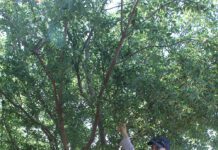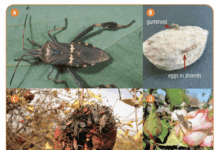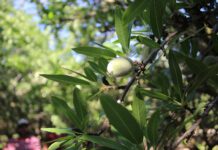
Comprehensive planning is crucial to ensuring a grower gets the most out of their investment. Some of these replanting considerations include proper planting, suitable irrigation methods, alternatives to soil fumigation and picking the right rootstock. A few of these topics were covered during The Almond Conference (TAC) in Sacramento, Calif. in December.
Soil Fumigation
Preplant soil fumigation can be crucial to combating many of the replant problems that stem from the previous crops planted on the same soil such as prunus replant disease (PRD). But with ever changing rules and regulations, growers might want to consider exploring fumigation alternatives.
USDA Plant Pathologist Greg Browne recently presented alternatives to soil fumigation during a presentation at TAC. He said there is some uncertainty that comes along with the tools available to growers like cost and regulatory issues as well as access uncertainties.
“We’re in an urban state, a lot of things changing fast, and so, for this reason, the Almond Board has really emphasized research programs that include an eye to alternatives to soil fumigation,” Browne said.
Browne pointed to a set of considerations before making soil fumigation or fumigation alternative decisions:
- Consider alternative treatments before removing old orchard for the best shot at accurately assessing phytopathogenic nematode populations.
- History of replant disease in adjacent/similar soils and replant scenarios? Have you had a problem with prunus replant disease before?
- Do you intend to fallow for several years before replant?
- Hybrid rootstock appropriate? Peach almond hybrids have been less susceptible to prunus replant.
Browne referred to an assessment matrix of the possibilities of where to put fumigants, whether in broadcast, strips or spots, each of which can be tailored to different pest problems.
“I think this kind of concept of thinking about the matrix of the problems we’re after and what tools we have to go with them, it also applies to alternatives to fumigation,” he said.
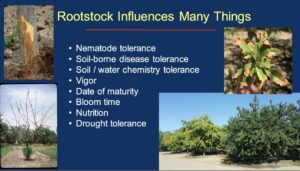
The Right Rootstock
Stanislaus County UCCE Orchard Crops Advisor Roger Duncan believes after more than 40 years of UC rootstock research, they have solid information on most of the commercial rootstocks available to almond growers today.
During a presentation at TAC, Duncan said choosing the right rootstock is probably more important than choosing varieties, particularly if you’re growing in an area that has a lot of challenges, since rootstocks influence so many things, including nematode and disease tolerance, soil and water chemistry tolerance, anchorage and vigor among others.
While Duncan said more research needs to be done with rootstocks on things like drought tolerance, enough research has been done to determine rootstocks do significantly affect nutrient uptake, particularly potassium and zinc among others.
Peach x almond hybrids may accumulate more leaf potassium than standard peach rootstocks.
“All of these things mean you may get more growth and higher productivity with some of these peach x almond hybrids and maybe reduce some input costs,” he said. But growers need to make sure they are a right fit for their conditions.
When it comes to nematode-resistant rootstocks, he said there aren’t any rootstocks that are truly resistant to root lesion nematode, but there are some that are less susceptible to ring nematode. Peach x almond hybrids in general, like Brights 5, Nickels, Cornerstone and Hansen, grow a lot of ring nematodes and are very susceptible to bacterial canker, while Viking and Guardian are the least susceptible.
“If you have ring nematodes and you’re not going to be able to fumigate, then you can look at this rootstock information and make a decision, maybe, to plant a more resistant rootstock to ring nematode,” Duncan said.
The most resistant rootstocks to phytophthora root and crown rot are generally varieties that are plum or half plum, while the peach x almond hybrids are highly susceptible as are Atlas and Viking.
“What’s interesting is some of the peach rootstocks like Nemaguard, for instance, they’re considered moderately susceptible, but they’re not as susceptible as peach x almond hybrids as a class,” he said.
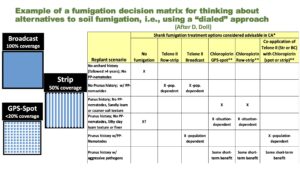
Anchorage is another important aspect of choosing a rootstock, according to Duncan.
“One of the things that happens over the years is you get trees that start to lean, so anchorage is pretty important,” he said.
Rootstocks with excellent anchorage include Viking, Krymsk 86, F x A and Hansen 536, Duncan noted.
Rootstocks for vigor and tree size are also important to consider, he explained, comparing a photo of a noticeably larger Nickels peach x almond hybrid next to a smaller Lovell peach rootstock.
“It means a lot of things in terms of yield potential,” Duncan said. “In general, rootstock vigor increases as you go from a plum or a plum hybrid rootstock up through the peach rootstocks, like Nemaguard, Guardian and Lovell, and the most vigorous in general are the peach x almond hybrids.”
Citing data from a trial that studied six harvests, Duncan said the highest-yielding rootstocks through the years were peach x almond hybrid rootstocks, while the lowest-yielding were industry standards, like Lovell, Krymsk 86 and Nemaguard. He said this data is closely related to vigor, but not solely.
“When you have a bigger tree, you’re able to outgrow some things, and you have more fruitwood produced every year, but we’re also seeing an increase in yield efficiency, generally a little larger yield per unit of canopy,” he said. “And that usually includes larger kernels.”
The data also showed the trees in the study would have yielded the grower $9,000 to $11,000 more per acre through the first six harvests if they had chosen one of the top peach x almond hybrid rootstocks compared to Nemaguard.
Citing several other studies that examined rootstocks for kernel size, orchard longevity and canopy size, Duncan said growers shouldn’t fall into the trap of doing what they have always done when it comes to rootstock.
“Look at your orchard, think about what your challenges are, and maybe you can take advantage of a different rootstock,” he said. “It can make a big difference in the profitability of your orchard.”
Proper Planting After WOR
When it’s time to plant your new almond orchard, there are a few important ways to handle bareroot trees ahead of getting them into the ground, according to UCCE Orchard Systems Farm Advisor for San Joaquin County Brent Holtz, who also presented on orchard replanting at TAC.
Holtz suggests keeping roots covered as long as possible to protect the carbohydrates stored within them, don’t prune roots too much and, if possible, treat roots with a product like Galltrol to prevent crown gall infections. It’s also important to consider the size of the roots when digging; the bigger the tree, the bigger the hole needs to be.
“I’ve seen planting crews smash up the roots into a ball and put them into small holes, so if you have a big tree, dig a big hole for that tree to allow space for settling,” Holtz said.
Trees should be planted high on a berm, with berms pulled up before planting, not after, he added, and trees should be planted so the nursery soil line is above the current soil line with the highest root slightly above the soil line, then covered with extra dirt. Holtz said it’s also important to not plant too deep and to be careful not to break any roots. Once planted, Holtz recommends watering the trees with one to three gallons of water, even if the soil is wet.
As whole orchard recycling(WOR) becomes the standard, Holtz said it’s important to consider how it can affect the soil. Citing a grower who he helped fix a carbon and nitrogen imbalance following WOR, he said it started a series of experiments to test how much fertilizer is actually needed after WOR and showed early fertilization can be quite beneficial.
He said a trial of 0.8 oz/N applied in early March showed great results.
“If we got that fertilizer in early, there was a really big difference, and it was amazing to see just in one month with that early fertilizer,” Holtz said.
In another trial, after adding 5 oz/N per tree at 45 pounds per acre, down from 100 pounds, he said at the end of the season, the WOR treatment looked larger than the control for the first time instead of the opposite. Trunk diameters showed a significant increase as well with WOR.
“We think there was some nitrogen mineralization going on,” he said. “A leaf analysis showed almost 4.5% nitrogen in leaf analysis. I’ve had some fertilizer trials where I don’t think I got much higher than that, so we got a good response with the same amount of fertilizer.”
Holtz said growers often ask if you can return organic matter back to the soil without negatively affecting the next crop, and he said the better you incorporate the wood chips into the soil, the less problem you’re going to have with a negative N tie-up. He noted one of the best methods is using a plow to incorporate the wood chips.
Another experiment Holtz conducted, the 2,000-barrel trial, aimed to determine how long it takes wood chips to become part of soil organic matter. Mixing 1/3-part wood chips to 2/3-part sandy loam soil in 35-gallon containers with one almond tree per container, he said 10 barrels received a wood chip mixture while 10 received soil only.
He noted a decrease in trunk circumference in the first four years compared to the control and after fourth-year trunk circumference evened out, with an increase seen in the fifth and sixth years from the wood chips.
“What was amazing was this was soil organic matter, and there was a spike at seven years I didn’t expect to encounter that lasted for 17 to 20 years and even at 23 years, the soil organic matter was still significantly greater in the wood chip treatment,” Holtz said, adding there were still significant carbon levels after 23 years.
He said the popularity of WOR began increasing with growers when funding became available through the San Joaquin Valley Air Pollution Control District, which released a report in 2023 that showed over 3,000 growers had received funding for WOR with 162,000 acres recycled since the program’s inception.
Holtz said additional funding will continue to be available to growers for WOR since Governor Newsom signed AB 2101 (Flora), the California Carbon Sequestration and Climate Resiliency Project Registry: Whole Orchard Recycling Projects, which approved an additional $178 million for WOR projects.
“There’s going to be some good funding for a couple of years in the future,” he said.
The presentation slides from each of these TAC sessions can be found at almonds.com under ‘Almond Conference past presentations.’



